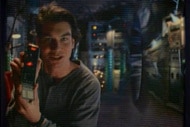Create a free profile to get unlimited access to exclusive videos, sweepstakes, and more!
WandaVision's 'cosmic microwave background radiation' is real, actually

Gravitonium, Vibranium, and Pym Particles are just a few examples of scientific nonsense in the Marvel universe. When Tony Stark says "Quantum fluctuation messes with the Planck scale, which then triggers the Deutsch Proposition. Can we agree on that?" Well, that's spectacular oral nonsense. Sure, there are some actual science words in there, but they make no contextual sense.
It's clear that Marvel likes to play fast and loose with scientific-sounding jargon. And why shouldn't they? It's part of their legacy. Stan Lee was well-known for his love of couching characters and stories in the set dressing of science without bothering too much about substance.
"I had The Hulk, he was inundated by gamma rays, that's how he became The Hulk. Now, again, I thought that sounded good. I wouldn't know a gamma ray if I saw it. I don't know what a gamma ray is. But if it sounds good, I'll use it," Lee said in a 2013 interview with PBS.
To be fair, gamma rays do exist outside the visible light spectrum. None of us would know a gamma ray if we saw it. But that's neither here nor there. The point is, Marvel doesn't give a Groot about scientific accuracy. So, when Dr. Darcy Lewis (Kat Dennings) expounded the wonders of cosmic microwave background radiation (CMBR) in last week's episode of WandaVision, you could have been forgiven for believing it to be just one more piece of silly Marvel science.
But, it turns out, in the words of Rocket Raccoon: IT'S REAL.
WHAT IS COSMIC MICROWAVE BACKGROUND RADIATION?
For the first few hundreds of thousands of years after the Big Bang, the universe was so hot that atoms couldn't exist. Instead, everything was a violent morass of orange plasma made of elementary particles. Think of the universe as having been one gigantic star making up all of existence and you'll be pretty close. Because of the dense collection of energetic particles, free electrons couldn't travel unimpeded. Instead, they bounced off other particles like balls on an endless Plinko board. Reality was a pile of flashbulbs in a house of mirrors.
The universe expanded, as the universe is wont to do, and the plasma cooled until, eventually, atoms could form. We got simple matter — electrons binding with protons to create hydrogen — and the universe became transparent. Those proverbial mirrors moved out of the way and that pervasive orange light from the early universe was suddenly free to travel more or less unfettered. And travel it did. The result: The dark and relatively empty-looking universe we observe today.
But if the universe was once entirely filled with light, where did it all go? It's still here, all around us, you just can't see it. Again, this is due to the expansion of the universe. As the universe expands, so too does the wavelength of that initial light.
Think of a slinky being stretched longer and longer — it's curling up and down, waves pulling taut. While the light originally existed in a visible wavelength, the stretching shifted it from visible, to microwave. We can no longer see it. At least not with our eyes. It can be picked up by radio telescopes. Or radio antennas. It can also be picked up by TV antennas, at least the kind that used to exist before the transition to digital.
If, when you were a kid, you ever turned the television between channels and saw that famed black-and-white static, you were seeing the cosmic microwave background of the universe. It's true that most of the static was the result of other, more local signals. But about one percent or so (the figures vary) of the static you saw on your screen came from one of the earliest events in the life of our universe.
Which is to say, in a manner of speaking, William Gibson was right. The sky above the port (and everywhere) is the color of a television tuned to a dead channel. And before about 380,000 years after the Big Bang, that was literally true. It just turns out, that color is orange.
USEFUL DATA
This is about where Dr. Lewis' observations diverge from reality and return to the philosophy of Stan Lee. There are variations in the CMB, owing to the variations in that initial light at the moment of recombination, but it's more or less static, so to speak, across the sky.
One wouldn't pick up an abundance of CMB radiation, as suggested in the episode, and if you did it wouldn't translate to a television signal. As previously stated, the majority of the static in an old (like, not flat) television came from terrestrial sources. Any signal coming from an earthly transmission, whether mundane or superhero-made, would exist within that remaining 99 percent of the static. The CMB wouldn't hold that signal, it would be something you'd have to filter out.
That doesn't mean, however, there isn't useful data to be culled from the Cosmic Microwave Background. Quite the contrary.
Cosmologist Ralph Apher first predicted the CMB in 1948 as a potential feature of the early universe, but it wasn't confirmed for another 17 years. In 1965, Arno Penzias and Robert Wilson of Bell Telephone Laboratories were building a radio receiver when they realized there was some signal they couldn't eliminate.
Try as they might, the signal persisted. Not only that, but it also showed up no matter where they pointed the receiver. It seemed as though the signal was coming from everywhere. Because, of course, it was. And it still is. Eventually, they realized the signal was the background radiation of the universe. Penzias and Wilson received the 1978 Nobel Prize in Physics for their discovery.
The presence of CMB tells us a few things about the early universe. For one thing, it's strong evidence for the Big Bang. It exists because the universe was once much denser and hotter than it is now. Not only does it support the theory of the Big Bang, but it also gives us a glimpse at what the universe was like shortly after.
It holds within it the structure of the light as it existed at the moment of recombination, like a fading snapshot that can still be seen with the right tools. For instance, a vintage TV. What CMB can't tell you is the current whereabouts of one Wanda Maximoff or Vision, not unless those whereabouts date back to 380,000 years after the Big Bang.


























